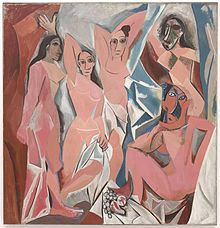The French Collection
The stories, illustrated in acrylic paint and written in ink surrounding the paintings, narrate Willia Marie's journey as she befriends famous artists, performers, writers, and activists (many of whom would not have lived during the era or in the region), runs a café and works as a painter, and develops a distinct Black feminist intellectual worldview based on her experiences and identity.
Exhibited as a full set for the first time in 1998, five of the quilts are now located in public museums and galleries across the United States while the remaining seven are in private collections.
The French Collection quilts are among Ringgold's most well-known works and have been extensively reproduced as prints, posters, and in popular media.
Ringgold traveled extensively in the early 1990s throughout France for visual inspiration using funding from her employer, the University of California, San Diego, as well as from the National Endowment for the Arts.
The quilts tell the narrative of Willia Marie Simone, a 16-year-old African American girl who is moving from Harlem, New York, to Paris, in 1920 to paint and model.
Willia Marie's Aunt Melissa gives her $500 for the journey and eventually agrees to care for her children, and they exchange letters over the course of her time in Europe.
[1] Ringgold's daughter has described the quilts and stories in The French Collection: How Willia Marie's life subsequently unfolds, rendering her ultimately a successful expatriate Black woman artist living in France, is explained in an elliptical series of stories, most but not all of which are presented in the form of letters home to Aunt Melissa.
The Île de la Cité and architecture of the city are visible behind her and tower over Willia Marie as she throws a bouquet into the river.
Wells, Mary McLeod Bethune, Fannie Lou Hamer, Rosa Parks, and Ella Baker, who comprise the fictional National Sunflower Quilters Society of America.
[9] Sunflowers Quilting Bee at Arles was originally made while Ringgold was creating other works commissioned by Oprah Winfrey.
In the dream, Betsy tells Willia Marie a story about meeting a white man who tried to shame her for being the descendant of enslaved people.
The man recounted a family story involving his grandparents, slavers from South Carolina, who had recoiled at the scent of bodies emanating from a slave ship in distress that they passed on a boat journey, only for their own boat to catch fire, forcing them to inhale the scent more deeply as they struggled to breath amid the smoke.
Several paintings are rendered on the wall in the salon, including Picasso's Portrait of Gertrude Stein (1905-1906) and works by Henri Matisse, Paul Cézanne, and Marie Laurencin.
In the text, Willia Marie tells her Aunt that she was commissioned to paint a portrait of Baker, whom she admires as a Black woman controlling her own artistic image and pursuits.
The figures depicted are Romare Bearden, Elizabeth Catlett, Ed Clark, Aaron Douglas, William H. Johnson, Sargent Johnson, Loïs Mailou Jones, Paul Gauguin, Vincent van Gogh, Jacob Lawrence, Edmonia Lewis, Archibald Motley, Raymond Saunders, Augusta Savage, Henry Ossawa Tanner, Henri de Toulouse-Lautrec, Maurice Utrillo, and Meta Vaux Warrick Fuller.
[21] Moroccan Holiday is the final work in the series and depicts Willia Marie and her daughter Marlena having a conversation in front of portraits of Frederick Douglass, Marcus Garvey, Malcolm X, and Martin Luther King Jr.
The title of Moroccan Holiday is derived from a trip that Ringgold took to find a location that felt emotionally resonant enough to serve as the backdrop of the conversation between Willia Marie and Marlena.
[22] In a 1998 review in The New York Times of Ringgold's show Dancing at the Louvre at the New Museum, Grace Glueck called the series "poignantly witty" and praised its "vivid sense of history" and "audacious imagination.





